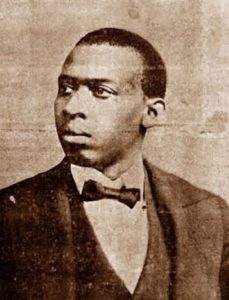
Patrick Chappelle
*Pat Chappelle was born on this date in 1869. He was a Black stage showman, theatre owner, and entrepreneur.
Patrick Henry Chappelle was from Jacksonville, Florida, the son of Lewis Chappelle and his wife Anna, who had been slaves in Newberry County, South Carolina. After slavery was abolished, they left South Carolina with their relatives and other freed slaves to help construct the suburban neighborhood of LaVilla in Jacksonville, which became a center of Black culture in Florida. He learned the show business ropes from his uncle Julius C. Chappelle, who allowed him to meet Franklin Keith and Edward F. Albee, producers of vaudeville.
In 1898, Chappelle organized his first traveling show, the Imperial Colored Minstrels (or Famous Imperial Minstrels). He also opened a pool hall in the commercial district of Jacksonville. Remodeled as the Excelsior Hall, it became the first Black-owned theater in the South, reportedly seating 500 people. In 1899, following a dispute with the white landlord of the Excelsior Hall, Chappelle closed the theatre and moved to Tampa, where he and R. S. Donaldson opened a new vaudeville house, the Buckingham, in the Fort Brooke neighborhood. The Buckingham Theatre opened in September 1899 and, within a few months, was reported to be "crowded to the doors every night with Cubans, Spaniards, Negroes and white people."
In December 1899, Chappelle and Donaldson opened a second theatre, the Mascotte, closer to the center of Tampa. A different reporter said, “These theaters have proven themselves miniature gold mines.” His next project was a touring show called A Rabbit's Foot. The difference between this tour and previous ones where the cast was sixty people, and all performers were comfortable. If black performers could tour on a white circuit, they would not be allowed to sleep in the hotels when they stopped to rest because of segregation. They slept on the bus because it was better than the floor. On Chappelle's tour, the Freeman described their travel accommodations as “their train of new dining and sleeping cars, which ‘tis said, when finished, will be a ‘palace on wheels.” Like his Famous Imperial Minstrel show, A Rabbit's Foot contained minstrels and a variety of acts while maintaining the expected vaudeville staging flare. Chappelle offered a show for everyone.
In the summer of 1900, Chappelle put the show into theatres rather than under tents, first in Paterson, New Jersey, then in Brooklyn, New York. In October 1901, the company launched its second season, with a roster of performers again led by comedian Arthur "Happy" Howe, and toured in Alabama, Mississippi, Georgia, and Florida. The show grew popular throughout the early 20th century and played in theatres and tents.
Trading as Chappelle Bros., he and his brothers, James E. Chappelle and Lewis W. Chappelle, rapidly organized a small vaudeville circuit, including theatre venues in Savannah, Georgia, Jacksonville, and Tampa. By 1902, it was said that the Chappelle Bros. Circuit had full control of the Black vaudeville business in that part of the country, "able to give from 12 to 14 weeks [of employment] to at least 75 performers and musicians" each season.
Chappelle stated that he had "accomplished what no other Negro has done - he has successfully run a Negro show without the help of a single white man." As his business grew, he owned and managed multiple tent shows, and the Rabbit's Foot Company would travel to as many as sixteen states in a season. The show included minstrel performances, dancers, circus acts, comedy, musical ensemble pieces, drama, and classic opera and was known as one of the few "authentic negro" vaudeville shows. It traveled most successfully in the southeast and southwest and Manhattan and Coney Island. By 1904 the Rabbit's Foot show had expanded to fill three Pullman railroad carriages and was advertised as "the leading Negro show in America." For the 1904-05 season, the company included week-long stands in Washington, D.C., and Baltimore, Maryland.
Two of its most popular performers were singing comedian Charles "Cuba" Santana and trombonist Amos Gilliard. Another performer, William Rainey, brought his young bride Gertrude (later known as "Ma" Rainey) to join the company in 1906. That year, Chappelle launched a second traveling tent company, the Funny Folks Comedy Company, with performers alternating between the two companies. The business continued to expand, though, in August 1908, one of the Pullman Company railroad carriages used by the show burned to the ground in Shelby, North Carolina, while several entertainers were asleep. Chappelle quickly ordered a new carriage and eighty-foot round tent so the show could go on the following week. Pat Chappelle, who helped pave the way for Black performers, died from an unspecified illness on October 21, 1911, aged 42.